The recent rescue of Rohingya refugees off the coast of West Aceh, Indonesia, has once again highlighted the dangerous journeys undertaken by Rohingya refugees seeking a better life in Southeast Asia. With increasing desperation, many Rohingya are risking their lives in overcrowded boats to escape dire conditions in Myanmar and Bangladesh.
Key Points On Rohingyas
- Rohingya refugees were rescued by an Indonesian search and rescue team when their boat capsized about 20 km off the coast of Aceh province, hours after departing from Bangladesh. A total of 69 individuals were saved
- With around 75 Rohingya rescued and the remaining feared drowned, the incident is a reflection of the growing desperation that is driving the refugees to flee Myanmar and overcrowded relief camps in Bangladesh for safer Southeast Asian countries.
- As per the United Nations High Commissioner for Refugees (UNHCR), over 4,500 Rohingya refugees set off on dangerous journeys across the Bay of Bengal and the Andaman Sea last year.
- Of these, 569 people lost their lives or went missing, marking the highest death toll since 2014.
Who are The Rohingyas?
- Muslims make up the majority of the Rohingya ethnic minority, which is mainly concentrated in the western Myanmar region of Rakhine. Rather than the widely spoken Burmese language, they speak a Bengali dialect.
- Although they have lived for many generations in the South East Asian nation, Myanmar views them as immigrants who came to their territory during the Colonial era.
- As a result, Rohingyas do not yet have full citizenship.
- A Rohingya (or any other ethnic minority) can only obtain citizenship under the 1982 Burmese citizenship law if they can demonstrate that their ancestors resided in the nation before 1823.
- They are categorized as “resident foreigners” or “associate citizens” if not (even if one of the parents is a Myanmar citizen).
The Rohingya Crisis
- The Rohingya crisis is a humanitarian disaster that has displaced more than a million people from their homes in Myanmar.
- The crisis escalated in 2017 when a militant group called the Arakan Rohingya Salvation Army (ARSA) attacked several police posts in Rakhine state
- Prompting a brutal crackdown by the security forces that killed thousands of civilians, burned hundreds of villages and forced hundreds of thousands to flee across the border to Bangladesh.
- The United Nations has accused Myanmar of committing genocide and ethnic cleansing against the Rohingya
Current Status of Rohingya Refugees
- While over one million Rohingya have fled Myanmar since the 1990s, around six lakh remain in the country, mostly in camps for internally displaced people where their movements and livelihoods are restricted
- An estimated 9,60,000 Rohingya, meanwhile, reside in refugee camps in Bangladesh.
- These overcrowded camps lack basic human necessities, forcing Rohingya to live in harsh conditions.
- There is a shortage of food, access to water is inadequate, sanitation facilities are missing, healthcare is insufficient, and children reportedly grow up without formal education.
- The camps are highly susceptible to weather-related disasters like storms, rains, flooding and highly exposed to fires and outbreaks of diseases due to insanitary conditions.
- With the option of returning to Myanmar virtually impossible, an increasing number of Rohingya have been undertaking dangerous sea journeys to the Muslim-majority nations of Indonesia and Malaysia.
- However, human traffickers exploit their desperation, charging exorbitant amounts to ferry them on rickety boats from Bangladesh to Indonesia
India’s Refugee Policy and the Rohingya
- India does not have a domestic law nor consistent policy on refugees and asylum seekers and is not a signatory to the 1951 Refugee Convention and its 1967 Protocol.
- All foreign undocumented nationals are governed as per the provisions of The Foreigners Act, 1946, The Registration of Foreigners Act, 1939, The Passport (Entry into India) Act, 1920 and The Citizenship Act, 1955.
- These acts require them to have valid documents, such as passports and visas, to stay in India.
- Without such documents, refugees are considered “illegal immigrants” and subject to detention and deportation.
- India has provided documentation and permission to some groups of refugees directly, while offering Long Term Visas (LTVs) to others.
- In 2011, the Ministry of Home Affairs (MHA) set out a standard operating procedure to deal with foreign nationals who claim to be refugees
- Other refugees are not recognized by India, but are allowed to register with UNHCR, which has had an office in the country since 1981
- These groups receive some assistance from UNHCR but none from the government of India and have been afforded fewer rights and recognition.
Status of Rohingya Refugees in India
- Today, approximately 49,000 refugees are registered with UNHCR in India, mostly from Myanmar (29,361) and Afghanistan (15,053), with smaller numbers from several African and Middle Eastern countries.
- When combined with the Tibetans and Sri Lankan Tamils recognized by India, UNHCR reports a total of more than 213,000 refugees and asylum seekers in India.
- Local groups told the team there are many more refugees who remain unregistered, partially due to UNHCR being based only in Delhi.
Conclusion
The plight of Rohingya refugees continues to be a severe humanitarian crisis. While countries like Indonesia and Malaysia have become destinations for those fleeing Myanmar, many Rohingya are facing life-threatening journeys across dangerous seas. In India, Rohingya refugees continue to live in uncertainty, with limited rights and opportunities for a better future. Governments, humanitarian organizations, and the international community must continue to work together to address the needs of Rohingya refugees and ensure their safety and dignity.
To Download Monthly Current Affairs PDF Click here
Click here to get a free demo
Discover all about CLAT Exam



